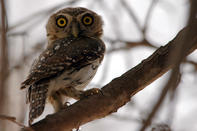
Name
Pearl-spotted owlet (Glaucidium perlatum)Appearance
Pearl-spotted owlets are one of Southern Africa’s smallest owls. They are only 18–19 cm and do not have ‘ear’ tufts. They have cinnamon brown heads with off-white facial disks. The upper parts are brown with numerous dusky rimmed white spots. Their underparts are white streaked with brown and their eyes are yellow.Pearl-spotted Owlet Diet
The pearl-spotted owlet feeds on a variety of prey, like insects, bats and small rodents. Although they mainly feed on invertebrates the powerful talons allow it to catch birds up to the size of large weavers, small mammals and reptiles. They have been recorded to take laughing dove weighing 200 g. This is an achievement considering the owlet only weighs around 85 g.
Pearl-spotted Owlet Breeding
Pearl-spotted owlets will breed from August to November in South Africa. The female lays 2 - 4 eggs in a tree cavity, often made by woodpeckers or barbets. Both parents possibly incubate the eggs for up to 31 days and the chicks become independent a few weeks later.Pearl-spotted Owlet Behaviour
While most owls are typically nocturnal, hunting under the cover of darkness, some owls use the daylight hours to avoid competition with and predation by their larger counterparts.
The pearl-spotted owlet is typically crepuscular, meaning that it is active early morning and late afternoon. Because it hunts during the daylight hours, it does not rely as heavily on the use of hearing to locate prey. The pearl-spotted owlet uses startle displays to ward off its enemies.
It has two eye-spots on the back of its head, that mimic real eyes, and a predator would be hard pressed to know for sure which way the owlet is really looking. This technique is used to dissuade attackers, as predators generally won’t pursue prey from the front, as they then lose the element of surprise critical for effective hunting. By Megan Emmett
Habitat
The pearl-spotted owlet is found in open savannah and semi open woodlands in South Africa. They tend to avoid areas with long grass, desserts and thick forests.Where they are found
Pearl-spotted owlets are widely spread in Southern Africa. They are mainly found in bushveld and woodland areas where they are commonly seen all year round. They are probably the most diurnal of the Southern African owls.
 Owls are divided into two main groups or families, the Strigidae and Tytonidae. The tytonids are screeching owls and include the grass and b...
Owls are divided into two main groups or families, the Strigidae and Tytonidae. The tytonids are screeching owls and include the grass and b... Symbiosis refers to a protracted relationship between two species, where one of the species may either benefit from the association, be nega...
Symbiosis refers to a protracted relationship between two species, where one of the species may either benefit from the association, be nega...